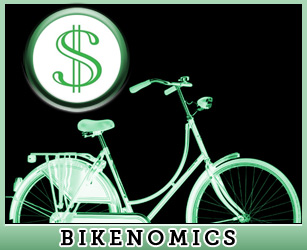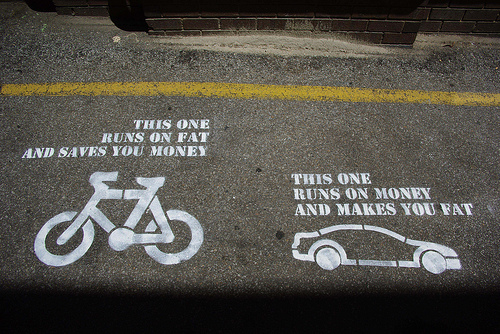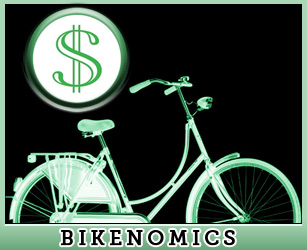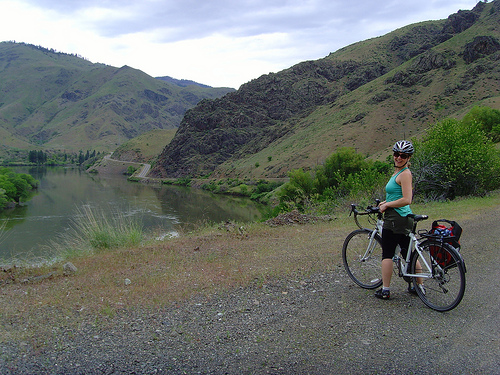 This is the 10th and last column in the Bikenomics series. A new 10-part series will begin in two weeks, exploring some of the different reasons people don’t bike for transportation and ways these obstacles to bicycling can be overcome.
This is the 10th and last column in the Bikenomics series. A new 10-part series will begin in two weeks, exploring some of the different reasons people don’t bike for transportation and ways these obstacles to bicycling can be overcome.
Conversations about transportation bicycling tend to revolve around work, particularly commuting.
This is a good thing. We need to get to work; more of us need to get to work by bike; and more bicycling means a healthier economy, a better workplace, and even more jobs.
But the commutes in these conversations are an endangered species, part of a type of work and lifestyle that’s fading fast: the 9-to-5 lifetime career with health benefits and pension, a commute from suburbs to central city, and a hot meal waiting for you when you get home.
The way we work has been changing for a long time, and our transportation needs and options along with it. With the recent recession, fewer people are working as much or for as much money, or as regularly — or at all. More of us are, in a word, poor.
We’re the ones who need bicycling the most. Yet the broke and the tenuously employed aren’t always reached by bicycle transportation advocacy, education, and services. When they are, the messages being promoted are not always relevant or welcome.
The mainstays of bike advocacy organizations are the three E’s: engineering, enforcement, and education — with a fourth E, encouragement, becoming increasingly popular.
Encouragement is a kind of marketing. It’s about selling the benefits of transportation bicycling as though it were a product. It’s appealing because, to a large extent, it works, imbuing everyday transportation bicycling with a certain cool cachet. Marketing, being what it is it, tends to be best executed by businesses and blogs selling everything from imported, upright city bikes to the concept of cycling fashion to the aesthetic and lifestyle associated with both of these.
But lately, advocacy organizations and even government agencies are investing in encouragement initiatives and seeing a lot of success. A recent example is the charming animated video made by the Cascade Bicycle Club called “Will you ride with Sophie?” that extols the environmental, social, and personal virtues of choosing to bike instead of drive, even for just a few trips a week.
And that’s the crux of it, what makes encouragement so appealing to some and so frustratingly divisive to others: When you’re broke, you simply don’t have the same choices. The risks you are willing to take are informed by different factors. What one person might feel as a stirring call to action, another might just as easily see as unwelcome and out-of-touch moralizing.
It’s understandable, of course, that the pursuit of encouragement, as well as the other E’s, is informed by the concerns of the advocates themselves. Part of the heritage of bicycle advocacy in the U.S. is recreational riding — an activity that suggests a decent enough income to have a nice bike in the garage and the leisure, skills, and confidence to go out and ride it whenever one chooses. U.S. bike advocacy is also imbued with a heavy focus on individual responsibility as more important — or perhaps more readily achievable — than social and infrastructure change, as exemplified by the until-recently prominent vehicular cycling movement.
Such initiatives tend to reach out to the people who ride — or don’t — out of choice rather than economic necessity, whose only barrier to getting on a bike is motivation.
When you’re already broke, you don’t need to be encouraged to adopt someone else’s lifestyle. You need solutions that arise from your own circumstances and community.
That means that simply choosing to hop on a bike isn’t actually that straightforward. Even as your car is sucking your savings dry and pummeling your credit, at least it’s the devil you know.
People living in low-income households are less likely to have access to a working bicycle (only 29 percent of households making less than $15,000 do, according to the NHTSA’s most recent survey). Aside from the cost and learning curve of acquiring, outfitting, and maintaining a reliable everyday bicycle, if you’re broke your neighborhood is also less likely to be graced by bike lanes, calmed traffic, and other facilities that are lauded for their ability to raise property values. You’re also less likely to have easy, central access to grocery stores and other amenities.
Bicycling has a reputation as being dangerous, making it even less appealing to those who lack health insurance. There’s also a social stigma attached — car ownership is a widely acknowledged symbol of success and adulthood.
Moreover, the pursuit of the three original Es — education, engineering, and enforcement — demands some further sensitivity if undertaken in the context of economic inequality.
When you’re low-income, you may simply not have access to the amenities of bicycle advocacy that others of us take for granted. Your concerns are less likely to be solicited or lobbied for. Education initiatives and materials about cycling laws and safety, what to do if you crash, and even how to ride at all are less likely to reach you and may not even exist in a language you read fluently. And engineering and enforcement are as likely to work against you as they are to protect and serve your interests.
 Photo: Carlton ReidThese concerns are hardly universal, but they’re a sampling of what advocates need to ask and engage about if they are serious about making bicycling more widely accessible and attractive.
Photo: Carlton ReidThese concerns are hardly universal, but they’re a sampling of what advocates need to ask and engage about if they are serious about making bicycling more widely accessible and attractive.
Of course, relatively elite bike advocacy organizations didn’t invent bicycling, and have much to learn from others who have already been doing it a long time. Among people in the U.S. who already ride, residents of socioeconomically disadvantaged neighborhoods are already riding for transportation rather than recreation. Bicycling is particularly embraced by recent immigrants from countries where bicycle transportation has long been the norm.
There are a lot of bike organizations out there that are already driven by the needs of low-income people and communities. Earn-a-bi
ke programs around the country empower participants with a free bicycle and the skills and knowledge to maintain and ride it well. Tamales y Bicicletas is a Minneapolis group run by and for Latino youth to build job skills and work for environmental justice. Ciudad de Luces/City of Lights is a Los Angeles program that provides free bike lights and bike safety and maintenance education to working-class Latino immigrants. In Madison, Wisc., police work with bike advocates and businesses to install free bike lights instead of writing costly tickets to those caught riding unlit at night.
As our economy shifts and bicycling becomes a more urgent economic imperative both individually and socially, advocates need to start seriously rethinking how their work can better serve the people who need it most. Initiatives that presuppose motivation as a primary to barrier for bicycling, or climate and public health concerns as a primary driver of transportation choices, will necessarily be limited in their reach, and run the risk of alienating people who, if listened to and engaged with, could be powerful allies.
I propose a fifth E for the bicycle advocacy toolkit: Economics. Not marketing, not the creation of wealth or the promotion of wealthy lifestyles, but rather the awareness of economic inequality and its impact on people’s choices and lack thereof. When we wander down the path of assigning moral value to lifestyle choices and take our policies cues from gender and identity politics, we lose a lot of people — and make enemies — along the way. When we focus on communities’ economic realities and the hard numbers behind them, then we can provide concrete, material tools for addressing the inequalities that are holding us all back.
The bicycle economy, after all, isn’t going to make most of us rich, and that’s OK. We could use fewer people getting rich in this country and more people getting by, feeling good, and having fun. Bicycling creates a little wealth. But more importantly, it creates a lot of well-being. That’s what the bicycle economy is all about.



